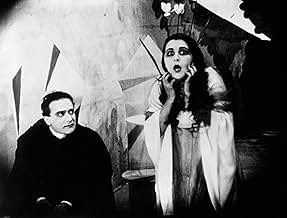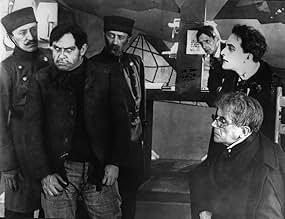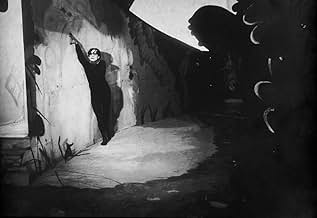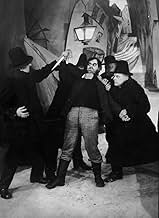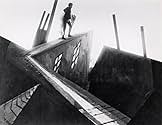IMDb RATING
8.0/10
74K
YOUR RATING
Hypnotist Dr. Caligari uses a somnambulist, Cesare, to commit murders.Hypnotist Dr. Caligari uses a somnambulist, Cesare, to commit murders.Hypnotist Dr. Caligari uses a somnambulist, Cesare, to commit murders.
- Awards
- 2 wins & 1 nomination total
Friedrich Feher
- Franzis
- (as Friedrich Fehér)
Hans Heinrich von Twardowski
- Alan
- (as Hans Heinz v. Twardowski)
Rudolf Lettinger
- Dr. Olsen
- (as Rudolph Lettinger)
Rudolf Klein-Rogge
- Ein Verbrecher
- (uncredited)
- …
Hans Lanser-Ludolff
- Ein Alter Mann
- (uncredited)
- …
Henri Peters-Arnolds
- Ein Junger Arzt
- (uncredited)
- …
Ludwig Rex
- Ein Mörder
- (uncredited)
- …
Elsa Wagner
- Die Wirtin
- (uncredited)
- …
- Director
- Writers
- All cast & crew
- Production, box office & more at IMDbPro
Featured reviews
Having only started discovering silent movies recently, I don't have more than a handful of other non-talkies to compare it to. This however was not only one of the best, most compelling and unique silents I have seen, but also a great flick overall. It's all been said before, I'm sure, but I'll say it again: this is a milestone of German Expressionist cinema. It is also a class-A mind-phuck movie (excuse my French), one of those stories that'll leave you eternally scratching your head trying to figure out what you've seen, what to believe and what can be a plausible explanation for most of the creepy mysteries you've just witnessed. Right from the very opening scene, seemingly suspended in an otherworldly dimension, maybe somewhere in between life and death, in which the first line spoken is: "There are spirits everywhere", you realise you are in for a spooky ride (this is the ultimate Halloween movie, come to think of it!) Having studied theatre set and costume design at Rome's art school for a year before going to university, I was obviously completely fascinated by the set design choices here. Buildings and furniture, props and painted backdrops are elongated and deformed into blocky, savage, expressionistic, perspective-defying and proportion-less forms. Even the intertitles weren't of the traditional sort. The result is obviously one of unsettling the viewer further into believing themselves suspended in a reality where anything could happen - anything horrible or nightmarish, obviously. Nothing is as it seems, right to the very end. Btw, on a more frivolous note, I thought the character of Cesare the Somnambulist looked uncannily like something that might have influenced Tim Burton into creating Edward Scissorhands, or maybe even more, the look of some of the characters in Rocky Horror Picture Show.
This picture is a masterpiece ! How could someone think in something like this at that time ? The film has really good casting ! Werner Krauss is excellent playing Doctor Caligari and Conrad Veidt (Cesare) too !
This movie has an obscure and bizarre mood makes the film looks really scary sometimes ... The painted scenario gave the film the touch that it needed ! It puts you in a nightmarish world , gives you the sensation of claustrofobia , depression and madness ! The objects have a strange shape and an irregular geometry that collaborate for the maintenance of the dark mood !
But the most important thing in this motion picture is the open ended story ! You´re never sure about the end ! It has so many ways of interpretation... It´s useless to try to define "one end" to this movie. You´ll be always asking yourself about the legitimacy of the man´s vision of the story.
It´s not scary , just sometimes , as I said. But it´s dark and it uses the shadows and lights effects so well that I was amazed the first time I saw and I still amazed ! German Films of that time were really good !
Congratulations to Robert Wienne and his cast ! It´s a masterpiece of madness and paranoia!
Rating : *****/******
This movie has an obscure and bizarre mood makes the film looks really scary sometimes ... The painted scenario gave the film the touch that it needed ! It puts you in a nightmarish world , gives you the sensation of claustrofobia , depression and madness ! The objects have a strange shape and an irregular geometry that collaborate for the maintenance of the dark mood !
But the most important thing in this motion picture is the open ended story ! You´re never sure about the end ! It has so many ways of interpretation... It´s useless to try to define "one end" to this movie. You´ll be always asking yourself about the legitimacy of the man´s vision of the story.
It´s not scary , just sometimes , as I said. But it´s dark and it uses the shadows and lights effects so well that I was amazed the first time I saw and I still amazed ! German Films of that time were really good !
Congratulations to Robert Wienne and his cast ! It´s a masterpiece of madness and paranoia!
Rating : *****/******
The original message of this film is fairly pedestrian (an outcry against the weak authority in Germany at the time), although the political intrigue surrounding the production led to a fascinating framing story which re-established "the authorities," and in turn made the UFA happy enough to distribute the film. This suggests that in its own time the political message of the film was fairly powerful, but compared to the work done in such films as The Golem, Nosferatu, and Metropolis it is not so far-reaching.
What sets this film apart from its contemporaries is its absolute commitment to the expressionist movement. Mutated sets, heavy dark/light makeup, light and shadow, and a Gothic storyline are classic expressionism. The photography is beautiful and so crisp that it creates an eerie sense that this hellish scene is actually the real world, and that our everyday lives are the delusional Technicolor dream of a madman.
While there are many better movies made in this period, I feel that this one is the pinnacle of the imagery that is characteristic of the expressionist art form. It is an absolute must-see for anyone who is interested in the Expressionist movement.
What sets this film apart from its contemporaries is its absolute commitment to the expressionist movement. Mutated sets, heavy dark/light makeup, light and shadow, and a Gothic storyline are classic expressionism. The photography is beautiful and so crisp that it creates an eerie sense that this hellish scene is actually the real world, and that our everyday lives are the delusional Technicolor dream of a madman.
While there are many better movies made in this period, I feel that this one is the pinnacle of the imagery that is characteristic of the expressionist art form. It is an absolute must-see for anyone who is interested in the Expressionist movement.
I vowed to see more horror films this year, and this was recommended to me, initially I was a little dubious with it being a hundred plus years old, and a silent film, but I have to say I have a real appreciation for it.
Without a doubt, this film must be the inspiration for the whole horror genre, a genre that scares and shocks people to this day, you can only I shine the profound effect that this film must have had on viewers back in its time.
Hugely atmospheric and creepy, if I'm honest, it is slow, and you do need to concentrate, or you'll lose it, no texting or phone play, it is a fairly intense watch, best of all is the ending, which really does come as a surprise, it's something of a twist.
It is definitely not for everyone, and if you're used to modern horror, you may find ten minutes of it an arduous task, but having watched Nose earlier in the year, I have a real appreciation for this early gem.
An admirable film, 8/10.
Without a doubt, this film must be the inspiration for the whole horror genre, a genre that scares and shocks people to this day, you can only I shine the profound effect that this film must have had on viewers back in its time.
Hugely atmospheric and creepy, if I'm honest, it is slow, and you do need to concentrate, or you'll lose it, no texting or phone play, it is a fairly intense watch, best of all is the ending, which really does come as a surprise, it's something of a twist.
It is definitely not for everyone, and if you're used to modern horror, you may find ten minutes of it an arduous task, but having watched Nose earlier in the year, I have a real appreciation for this early gem.
An admirable film, 8/10.
With a story as twisted, buckled and demented as the scenery and set design, and a tortured score to boot, was the lunatic in charge of the asylum? Must have been a moment to remember coming across this cinematic marvel back in 1920. I wonder how many of today's pieces of cinema will stand the test of 100 years, albeit with a lot more competition.
Did you know
- TriviaWriter Hans Janowitz claims to have gotten the idea for the film when he was at a carnival one day. He saw a strange man lurking in the shadows. The next day he heard that a girl was brutally murdered there. He went to the funeral and saw the same man lurking around. He had no proof that the strange man was the murderer, but he fleshed the whole idea out into his film.
- GoofsIn the wide shot, the sign at the asylum reads "Insane Asylum," in English. In the close-up, the sign is written in German (Kino Blu-ray Disc version, may not be present in all editions of the film).
- Alternate versionsUSA laserdisc reissue restores the original hand-drawn title cards that have been missing from every known print of the film since 1923. When first released on video in the United States, film was in black-and-white, and played back many scenes at double speed and featured different music. Although no scenes were cut out, the running time was reduced to only 51 minutes. The restored version restores the colour-tinting, restores the original title cards, and plays the film back at regular speed, returning the film to its original 69-minute running time.
- ConnectionsEdited into People Who Die Mysteriously in Their Sleep (2004)
Details
- Release date
- Country of origin
- Language
- Also known as
- El gabinete del Dr. Caligari
- Filming locations
- Production company
- See more company credits at IMDbPro
Box office
- Budget
- $18,000 (estimated)
- Gross US & Canada
- $8,811
- Gross worldwide
- $9,297
- Runtime
- 1h 18m(78 min)
- Sound mix
- Aspect ratio
- 1.37 : 1
Contribute to this page
Suggest an edit or add missing content


